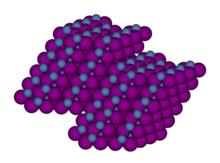Nickel(II) iodide is an inorganic compound with the formula NiI2. This paramagnetic black solid dissolves readily in water to give bluish-green solutions,[1] from which crystallizes the aquo complex [Ni(H2O)6]I2 (image above).[2] This bluish-green colour is typical of hydrated nickel(II) compounds. Nickel iodides find some applications in homogeneous catalysis.

| |

| |
| Names | |
|---|---|
| IUPAC name
Nickel(II) iodide
| |
| Other names
Nickelous iodide
| |
| Identifiers | |
3D model (JSmol)
|
|
| ECHA InfoCard | 100.033.319 |
PubChem CID
|
|
| UNII | |
CompTox Dashboard (EPA)
|
|
| |
| |
| Properties | |
| I2Ni | |
| Molar mass | 312.5023 g·mol−1 |
| Appearance | iron-black solid (anhydrous) bluish-green solid (hexahydrate) |
| Density | 5.384 g/cm3 |
| Melting point | 780 °C (1,440 °F; 1,050 K) (anhydrous) 43 °C (hexahydrate, loses water) |
| 124.2 g/100 mL (0 °C) 188.2 g/100 mL (100 °C) | |
| Solubility | alcohols |
| +3875.0·10−6 cm3/mol | |
| Hazards | |
| NFPA 704 (fire diamond) | |
| Related compounds | |
Other anions
|
nickel(II) chloride, nickel(II) bromide, nickel(II) fluoride |
Other cations
|
cobalt iodide, copper iodide, |
Except where otherwise noted, data are given for materials in their standard state (at 25 °C [77 °F], 100 kPa).
| |
Structure and synthesis
editThe anhydrous material crystallizes in the CdCl2 motif, featuring octahedral coordination geometry at each Ni(II) center. NiI2 is prepared by dehydration of the pentahydrate.[3]
NiI2 readily hydrates, and the hydrated form can be prepared by dissolution of nickel oxide, hydroxide, or carbonate in hydroiodic acid. The anhydrous form can be produced by treating powdered nickel with iodine.[4]
Applications in catalysis
editNiI2 has some industrial applications as a catalyst in carbonylation reactions.[5] It is also has niche uses as a reagent in organic synthesis, especially in conjunction with samarium(II) iodide.[6]
Like many nickel complexes, those derived from hydrated nickel iodide have been used in cross coupling.[7]
References
edit- ^ Lide, D. R., ed. (2005). CRC Handbook of Chemistry and Physics (86th ed.). Boca Raton (FL): CRC Press. ISBN 0-8493-0486-5.
- ^ Louër, Michele; Grandjean, Daniel; Weigel, Dominique (1973). "Structure Cristalline et Expansion Thermique de l'Iodure de Nickel Hexahydrate" (Crystal structure and thermal expansion of nickel(II) iodide hexahydrate)". Journal of Solid State Chemistry. 7: 222–8. doi:10.1016/0022-4596(73)90157-6.
- ^ Ward, Laird G. L. (1972). "Anhydrous Nickel(II) Halides and their Tetrakis(ethanol) and 1,2‐Dimethoxyethane Complexes". Anhydrous Nickel (II) Halides and their Tetrakis(Ethanol) and 1,2-Dimethoxyethane Complexes. Inorganic Syntheses. Vol. 13. pp. 154–164. doi:10.1002/9780470132449.ch30. ISBN 9780470132449.
- ^ Greenwood, N. N.; Earnshaw, Alan (1990). Chemie der Elemente (in German). Weinheim. p. 1476. ISBN 978-3-527-26169-7. OCLC 46170372.
{{cite book}}: CS1 maint: location missing publisher (link) - ^ W. Bertleff, M. Roeper, X. Sava, "Carbonylation" in Ullmann’s Encyclopedia of Industrial Chemistry, Wiley-VCH: Weinheim, 2003. doi:10.1002/14356007.a05_217.
- ^ Shinichi Saito (2008). "Nickel(II) Iodide". Encyclopedia of Reagents for Organic Synthesis. John Wiley & Sons. doi:10.1002/047084289X.rn00843. ISBN 978-0471936237.
- ^ Everson, Daniel A.; Shrestha, Ruja; Weix, Daniel J. (2010-01-27). "Nickel-Catalyzed Reductive Cross-Coupling of Aryl Halides with Alkyl Halides". Journal of the American Chemical Society. 132 (3): 920–921. doi:10.1021/ja9093956. PMID 20047282.
